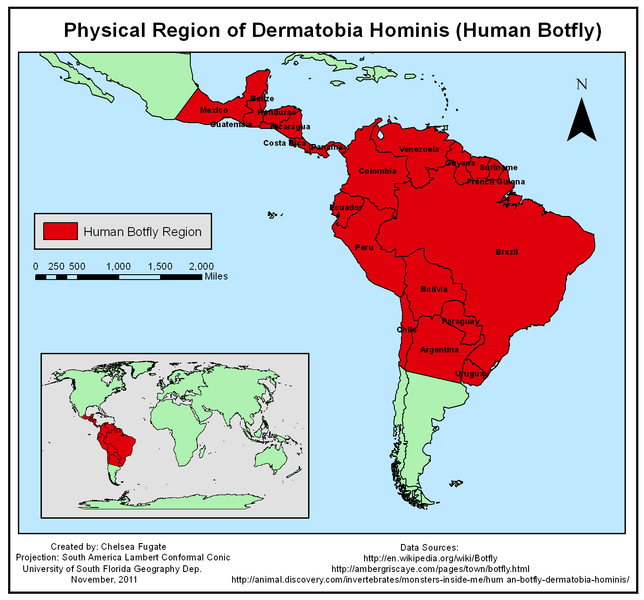Habitat
Dermatobia hominis is native to Central and Southern American
countries. The areas where they are most commonly found can is
anywhere between southern Mexico to northern Argentina (Bangsgaard
et al., 2000). Dermatobia hominis has been reported in other
countries and regions, this infrequent occurrence is usually due
to travelers visiting a central or southern American country.
There has been an increase in the number of foreign travelers
found with infestations of the botfly, with the increase and
availability of foreign travel. These flies are most commonly
seen around forest and jungle areas, more specifically around
water sources such as rivers and streams (Schwartz, 2009).
Their growth and reproduction depend on the climate in their area, which is why they are most commonly found in tropical areas near a water source. Relative humidity and soil moisture play a significant role in the development and success of Dermatobia hominis larvae. The larvae after emerging from a host’s skin will fall to the ground to complete its life cycle, the percentage of successful emergence of pupae from the ground ranges from 1-3% on dry soil and up to 40-50% on moist soil (Pinto et al., 2002). The botflies don’t thrive well in dry seasons of the tropical areas they are found in. To combat this they travel to the moist and shaded protection of an evergreen forest (Janzen, 1976).
Adult D. hominis has many species interactions including capturing a
fly in mid-flight, all of this is preformed while having poor eye
sight. Dermatobia hominis has a very developed sensory system which
is specialized for chemoreception. The main organ involved in the
sensory system is the sensilla. The sensilla sense certain aspects
of the environment including odors, humidity, temperature,
mechanical stimuli, and infrared radiation (Fernandes et al., 2002). Males and female adult botflies have
different morphological features associated with the sensilla,
differences include the structure and amount present on body. The
difference between the sexes may be due to the female role of
capturing other flies as vectors. (Fernandes et al., 2002).
Now that you know where to find D. hominis continue to Reproduction